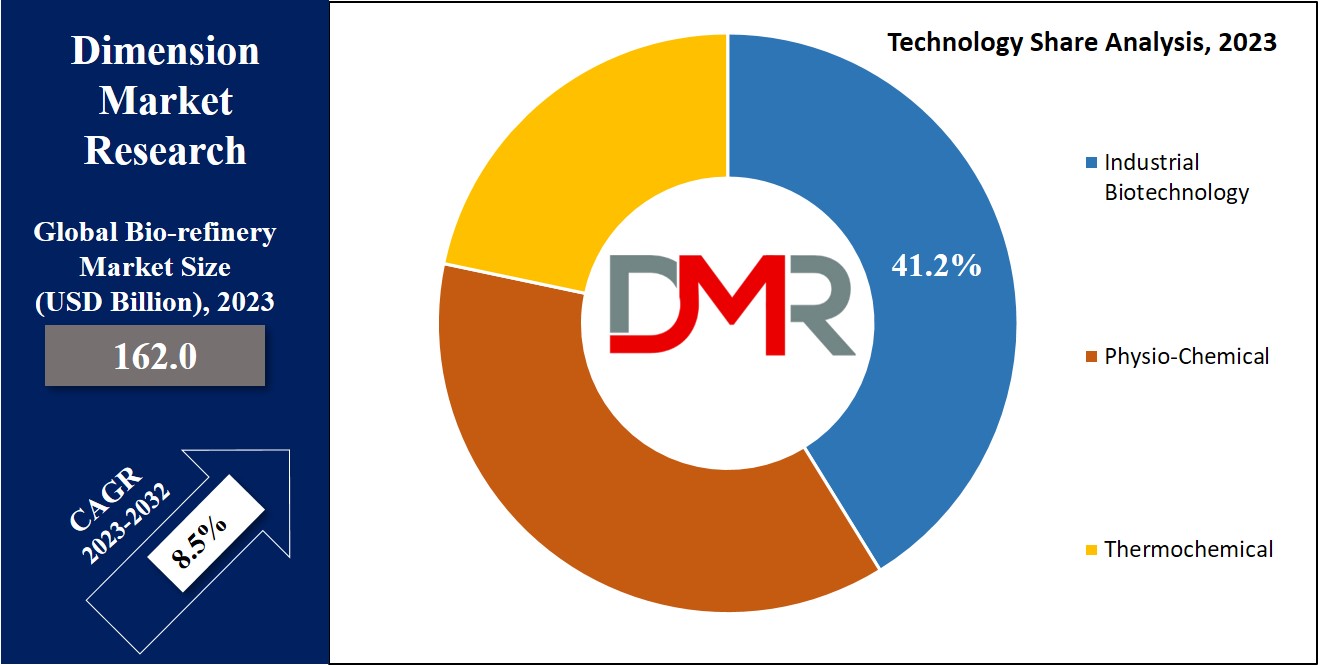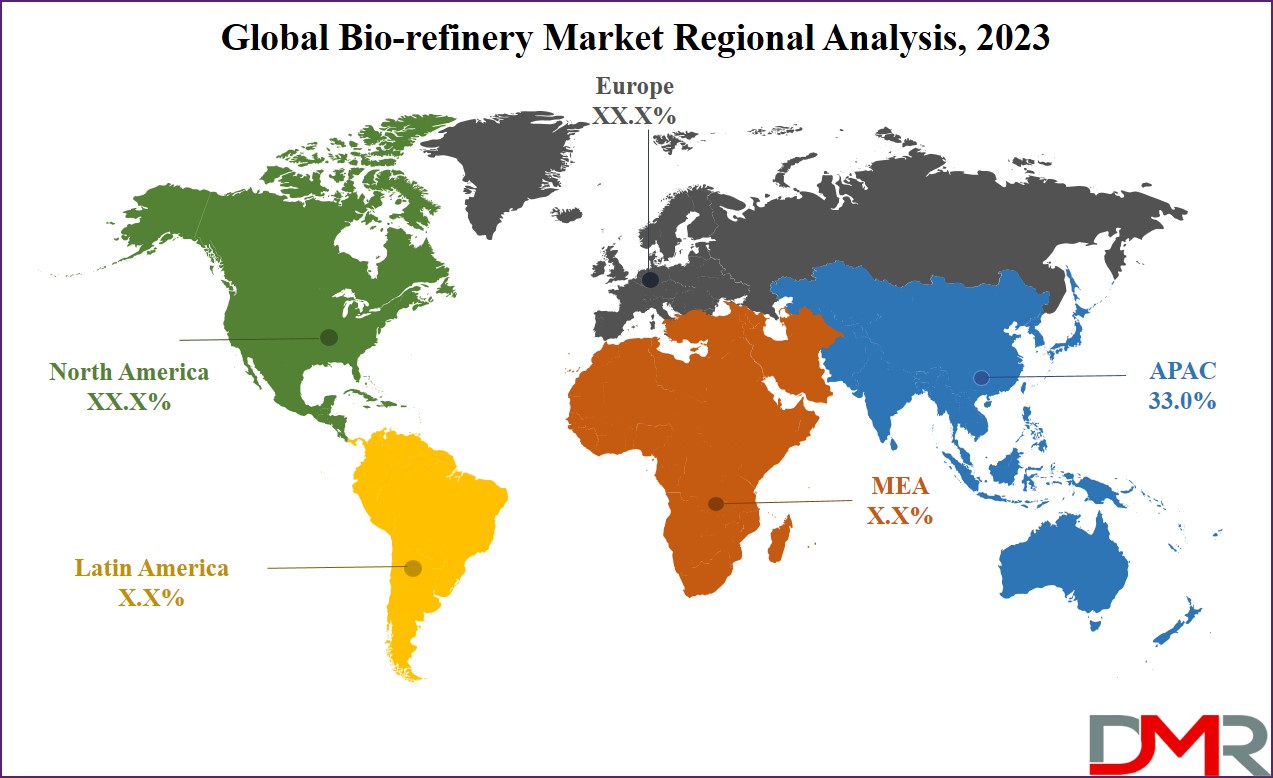Market Overview
The Global Biorefinery Market is estimated to be valued of
USD 162.0 Billion in 2023 and is further anticipated to
reach 337.9 Bn by 2032 with a CAGR of 8.5%.
The Global Biorefinery Market refers to an emerging & dynamic sector within the bio-based products economy that focuses on the conversion of biomass or waste materials, such as forestry & agricultural residue into biofuels, bioenergy and biomaterials. Global Biorefinery Market utilize renewable energy resource to replace traditional energy resources like petrol, diesel and gases.
This market is expected to grow further in the future as it utilizes a sustainable approach to maximize the value of the bio-resources to minimize the environmental impact. This market solves the energy security issues which are the long-standing concerns because of the limited sources of traditional energy sources around the world.
Market Dynamic
The Global Biorefinery Market improves the energy security issue in diverse ways, such as the conversion of waste products into biofuels which solves the problem to a greater extent. It also uses biomass and a source of renewable energy which helps in electricity generation. This market leaves a lower carbon footprint as compared to other sources. The countries have to follow a strict guidelines issued by the UNEP (United Nations Environmental Programme) to control their carbon emission rate and switch to sustainable energy resources. As for this problem, the bio-refinery market help meet climate change commitments and help them control carbon emission.
The Global Biorefinery market has many advantages but there are also some restrains. The major restraints this market faces are a lack of high Initial capital investment, and the availability and quality of feedstock that is used for production causes a major effect on the quality of the product. But even after such restrictions and problems, it is important to remember that there is still a wide area of opportunities.
Research Scope and Analysis
By Type
In the Global Biorefinery Market, the segmentation done based on generations shows the evolution of technology used in this market. The first-generation biorefineries were mainly based on
food & feed crops. The feed crops such, as corn, sugarcane & vegetable oils are used to create biofuels like bioethanol and biodiesel. The biofuels are used for transportation & energy purposes the reason for the need for second generation was because of less capability to produce crop-based biofuels and its impact on market food prices.
The second generation uses food biomass sources like agricultural & forest residues. It produces advanced biofuels such as renewable diesel and cellulosic ethanol.
The third-generation biorefineries are mainly focused on utilizing microorganisms & microalgae to produce biofuels. The major challenge this generation faces is the cultivation and extraction method of the algae but even if there are some major challenges present it still shows a very promising growth potential. This segment gives companies and researchers around the world a to gain a new edge over the market.
By Feedstock
Based on feedstock the Global Bio-refinery Market is segmented into Sugar & Starch Corps, Energy Corps, Multi-feedstock and Organic & Agriculture Residue. The Sugar and starch-based products in this market are anticipated to capture a significant amount of share due to their ease of availability. In this segment, the Sugar & starch-rich crops like sugarcane, corn & sorghum which have high carbohydrate content are suitable for the production of biochemicals & biofuels like ethanol and lactic acid.
The energy crop-based products are made up of plants like switchgrass, willow & miscanthus which are specifically grown for the production of biofuels like cellulosic ethanol and bio gases. The
agricultural & organic residue uses crop and forest residues like wheat straws or food wastes. These are used for the manufacture of biochemical & biofuels. The feedstock-based segmentation addresses the aspects of the quality of feedstock, its growth potential and sustainability. Understanding these points will give the market a better view of future growth prospects.
By Product
The Global Biorefinery market is categorized into two by product type energy driven and material driven which provides valuable insight into different products and their impact on the industry. The energy-driven market is anticipated to hold a larger section of the market in the forthcoming years. The energy-driven biorefineries focus on the production on the production of biogas, electricity & biofuels like bioethanol & biodiesels. The reason behind their popularity is the availability of feedstock, higher market demand and easy access. In recent times, as the price of petrol & diesel is surging, biofuels have become another budget-friendly option.
The material-driven global biorefinery market focuses on the production of biochemicals, bio-plastic & bio-composites. The energy- driven items in this market are labelled green which signify that these are an environment-friendly and sustainable item. These advantages make them popular among consumers and going to be a factor in their future growth.
By Technology
The Global Bio-refinery Market is segmented into three types Industrial biotechnology, Thermochemical and physiochemical based on technology, where, Industrial Biotechnology holds the majority market share. The reason behind the hold of industrial biotechnology in this market is because of the use of bio-organisms in the production of biofuels. The production processes include enzymatic hydrolysis, fermentation and microbial conversion techniques. This area focuses on the quality and efficiency of the product which makes it popular among consumers.

Further, Thermochemical technology is also popular among manufacturers and extensively used. In this technology, bio-refineries use chemical reactions instead of biological processes such as pyrolysis & gasification for the conversion of biomass into biofuel. This technology is specially used for the production of lignocellulosic feedstocks.
The Global Biorefinery Market Report is segmented based on the following:
By Type
- First Generation
- Second Generation
- Third Generation
By Feedstock
- Starch and Sugar Corps
- Energy Corps
- Organic and Agriculture Residue
- Multi-feedstock
By Product
- Energy Driven
- Material Driven
By Technology
- Industrial Biotechnology
- Physio-Chemical
- Thermochemical
Regional Analysis
Asia-Pacific is expected to hold the largest share of 33.0% of the global Bio-refinery market in 2023. As for the reason, the primary reason can be the increasing pressure of the International Organizations such as the UN, UNEP (United Nations Environmental Programme), UNFCCC (United Nations Framework Convention on Climate Change) and other environmental organizations on this region. Another reason can be the flexible government policies, increasing demand and technological advancements.

Moreover, North America is another rapidly growing market in the global biorefineries market which is expected to show more potential in the upcoming years. The reason behind this region's growth potential can be attributed to its high infrastructure facilities, high-tech population and industrial evolution.
By Region
North America
Europe
- Germany
- The U.K.
- France
- Italy
- Russia
- Spain
- Benelux
- Nordic
- Rest of Europe
Asia-Pacific
- China
- Japan
- South Korea
- India
- ANZ
- ASEAN
- Rest of Asia-Pacific
Latin America
- Brazil
- Mexico
- Argentina
- Colombia
- Rest of Latin America
Middle East & Africa
- Saudi Arabia
- UAE
- South Africa
- Israel
- Egypt
- Rest of MEA
Competitive Landscape
The leading giants in this market heavily invest in their research and development to get a step forward which will help them expand their product catalog. In this market, you can see many organic and inorganic strategies. The inorganic strategies include partnerships, acquisitions of small companies and collaboration whereas the organic method mainly consists of research and development of new products, their launch and acquiring its patent.
The Global Biorefinery Market landscape is led by industry giants such as Orstead, UPM Global, Dominion Energy Service Company, Honeywell International Inc., IES Biogas and other key players. These giants are famous for their new innovative products and advancements which make them stand out. The evolution of this industry id driven by the quest for a more efficient, safe and sustainable method of biofuel production.
Some of the prominent players in the Global Bio-refinery Market are:
- Honeywell International Inc.
- Chempolis
- Sekab
- UPM Global
- Green Plains Renewable Energy
- Lanxess A.G.
- DSM NV
- IES Biogas
- Valero Energy Corp
- Bayer Material Science LLC
- Dominion Energy Service Company
- Du Pont De Nemours
- Archer Daniels Midland Company
- Other Key Players
COVID-19 Pandemic & Recession: Impact on the Global Bio-refinery Market:
The COVID-19 pandemic hampered the growth of the Global Biofuel Market. During the pandemic, it affected the supply chains globally due to the unavailability of feedstock material required for production. The pandemic also led to a shift in the demand for biofuel products the demand for biofuel decreased because of travel restrictions and reduced economic activity lowered fuel consumption. Many regional biorefinery companies faced repercussions of the recession such as the reduction in revenue and increased operational costs of plants.
It is needed to note that even if the pandemic hampered the growth of this market it still showed the importance of environment-friendly and sustainable products, As countries around the globe are transitioning in the post-pandemic era, the biorefinery industry is expected to continue to evolve and grow further as the demand of sustainable products will increase.
Report Details
| Report Characteristics |
| Market Size (2023) |
USD 161.7 Bn |
| Forecast Value (2032) |
USD 340.1 Bn |
| CAGR (2023-2032) |
8.6% |
| Historical Data |
2017 - 2022 |
| Forecast Data |
2023 - 2032 |
| Base Year |
2022 |
| Estimate Year |
2023 |
| Report Coverage |
Market Revenue Estimation, Market Dynamics, Competitive Landscape, Growth Factors and etc. |
| Segments Covered |
By Type (First Generation, Second Generation & Third
Generation), By Feedstock (Starch and Sugar Corps,
Energy Corps, Organic and Agriculture Residue &
Multi-feedstock) ,By Product (Energy Driven &
Material Driven) and By Technology (Industrial
Biotechnology, Physio-Chemical &Thermochemical ) |
| Regional Coverage |
North America – The US and Canada; Europe – Germany, The UK, France, Russia, Spain, Italy, Benelux, Nordic, & Rest of Europe; Asia- Pacific– China, Japan, South Korea, India, ANZ, ASEAN, Rest of APAC; Latin America – Brazil, Mexico, Argentina, Colombia, Rest of Latin America; Middle East & Africa – Saudi Arabia, UAE, South Africa, Turkey, Egypt, Israel, & Rest of MEA
|
| Prominent Players |
Honeywell International Inc., Chempolis, Sekab, UPM
Global, Green Plains Renewable Energy, Lanxess A.G.,
DSM NV, IES Biogas, Valero Energy Corp, Bayer
Material Science LLC, Dominion Energy Service
Company, Du Pont De Nemours, Archer Daniels
Midland Company and Other Key Players |
| Purchase Options |
We have three licenses to opt for: Single User License (Limited to 1 user), Multi-User License (Up to 5 Users), and Corporate Use License (Unlimited User) along with free report customization equivalent to 0 analyst working days, 3 analysts working days and 5 analysts working days respectively. |
Frequently Asked Questions
The Global Biorefinery Market refers to an emerging & dynamic sector within the bio-based products
economy that focuses on the conversion of biomass or waste materials, such as forestry & agricultural
residue into biofuels, bioenergy and biomaterials.
The Global Biorefinery Market is expected to reach a market share value of USD 162.0 Billion in 2023
and is further anticipated to reach a CAGR of 8.5%.
The Global Biorefinery Market landscape is led by industry giants such as Orstead, UPM Global,
Dominion Energy Service Company, Honeywell International Inc., IES Biogas and other key players.
The major challenges the Global Bio-refinery Market faces are lack of infrastructure, capital investment,
technological complexity & unavailability of livestock and its quality.